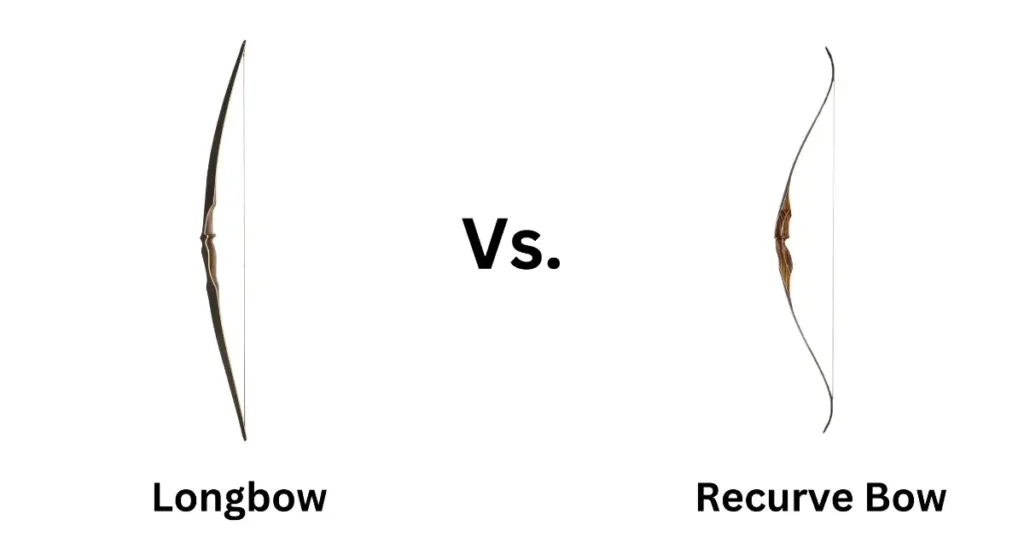When it comes to archery, few debates match the “Longbow vs Recurve Bow” divide. Archery isn’t just a sport; it’s a heritage, a craft that’s survived centuries, and the equipment is as central to the experience as the archer’s skill.
The choice between a longbow vs recurve bow is more than just a matter of historical preference; it’s a nuanced decision that hinges on many factors, including individual style, intended use, and even the soulful connection one seeks with their bow. For the archery enthusiast looking to draw the perfect bow, this comparison guide will help you aim true.
Understanding the Longbow
A Legacy Spanning Centuries
The longbow holds mythical status in archery history. Renowned for its simplicity, a longbow is a straight piece of wood that, when strong, becomes a formidable weapon. Historically, it was the bow of choice for the English and Welsh armies during the medieval period. It is often associated with the fabled English archers who won battles like Agincourt.
The Longbow Art
The longbow’s appeal lies in several core elements:
- Design Simplicity: The longbow is deceptively simple, a clean and elegant weapon with no mechanical advantages like those found in more modern recurve and compound bows.
- Smooth Draw: The longbow’s draw can be smoother than some recurve bows, due to its longer draw length.
- Kinetic Energy: Longbows are known for their incredible kinetic energy and punch, making them suitable for hunting large game.
The Longbow’s limitations
Longbows, while powerful, are less forgiving than other bows. They require extensive training to handle correctly and are less suited to precision and accuracy over long ranges.
Recurve Bow Unveiled
A Tale of Evolution
The recurve bow is a cousin, so to speak, of the longbow, but with key differences. It features tips that curve away from the archer before curving back toward the bow, which gives it additional power through leverage.
Recurves Bow for Modern Archery
- Compact Power: The recurve bow is renowned for its compact size and ability to pack potent energy into a smaller frame.
- Versatility: The recurve bow is incredibly versatile, used in competitions, hunting, and even the modern Olympics.
- Ease of Drawing: Unlike longbows, the recurve is easier to draw, which makes it more accessible to beginners without sacrificing its power.
Bowfishing and Recurves
Archers interested in bowfishing are often drawn to the recurve due to its ability to launch arrows with exceptional speed and stability. This is crucial in a dynamic, unpredictable environment.
Factors to Consider When Choosing a Bow
Draw weight and length
Understanding and matching the right draw weight and length of a bow to your physique and skill level is crucial. The wrong specifications can lead to poor form, inconsistency, and even injury.
Accuracy and distance
While both bows have superior accuracy, the recurve’s design often gives it a slight edge. Additionally, the recurve bow’s construction shoots at faster speeds, translating into greater distance.
Maneuverability and portability
In the realm of ease of use and transport, the recurve again has an advantage. Its three-piece takedown design makes it easy to carry, store, and replace parts.
Skill Level and Preference
Archery is an incredibly personal sport. The choice between longbow and recurve is often a matter of personal preference and the feeling an archer gets when using a particular bow.
A Head-to-Head Comparison
Longbow Dominance
For the traditionalist or those looking for the challenge of mastering a more demanding bow, the longbow is difficult to beat. With its raw power and smooth draw, it stands out as an ancient art that has been perfected for thousands of years.
The Recurve’s Modern Edge
Recurves bridge tradition and modernity. They offer increased performance, precision, and versatility, making them a popular choice for archers.
In Which Scenarios Do They Excel?
Hunting
For hunting, the longbow is often favored due to its quiet release and high kinetic energy. This makes it better suited to taking down game without alerting nearby animals.
Target shooting
In target shooting, especially over long distances, the recurve with its compound-like performance often becomes the bow of choice for both beginners and seasoned archers.
Recreational use
When it comes to recreational shooting or traditional archery, both the longbow and recurve have a place. It all comes down to personal taste and style.
Conclusion : Make The Right Choice Between Longbow Vs Recurve Bow
The question of “Longbow Vs Recurve bow which bow is better?” ultimately depends on you – your level of experience, physicality, and the type of archery you wish to pursue. Whether drawn to the storied simplicity of the longbow or the dynamic potential of the recurve, the most critical thing is to choose a bow that feels right. This enables you to enjoy archery.
Whichever bow you select, the choice should be made not just with your mind but with your heart. This is for archery is a sport that intertwines the physical with the philosophical, the practical with the poetic. Make your choice, draw your bow, and may your arrows always find their mark, wherever your archery adventure takes you.
Recent Posts
- Discover The Art Of Crossbows And Their Many Uses
- Longbows For Beginners: A Beginner’s Guide
- Discover The Joy Of Archery With A Bow And Arrow For Beginners
- Traditional Archery For Beginners – Getting Started
- Hit The Target With This Ultimate Guide To Archery For Beginners
- Mastering The Art Of Recurve Bow Archery For Beginners







